|
Alan R. Ludmer,
U.S.A.
part 4.8
Label and Ita's Children Emigrate to the
USA, RSA, and
Israel:
It is said that the only
constant is change.
Social,
political, and economic forces have some family to again relocate.
Future readers should note that emigration is not permanent. For
example, some descendants of those who went to the RSA are now living in
the USA,
Australia, and Israel.
|
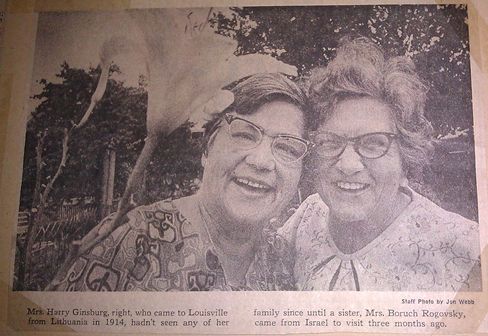
L. Tziporah Rozovsky
and Celia Ginsburg.
Louisville Courier Journal
article 1970
Celia
Fox Ginsburg.
(1900-1980)
Shule Frume,
a.k.a. Celia.
Celia was the only one of Label's
children to immigrate to the USA.
At age 14, she came to
Louisville, KY
in 1914 and was raised by her Aunt Sarah Fuchs Gradman as part of her
family.
In
Louisville, Celia married Harry Ginsburg, a
tailor, and raised two children Irvin and Ruth. I remember Harry as
quiet and reserved, but always nice. Both Irvin and Ruth inherited their
mother's out going nature and sense of fun.
I
remember Celia as a happy, cheerful person.
She
danced and sang at every family event. My mom (Dorothy Gradman Ludmer -
Sarah's daughter) remembers that Celia loved to dance and party, much to
Grandma Sarah's concern.
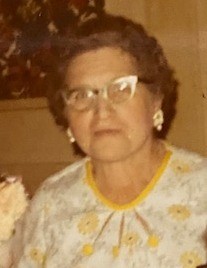 Celia
Ginsburg 1970 Celia
Ginsburg 1970
Additional information Yudit Natkin/Gertie Lipman:.
Gertie Lipman remembers: Your grandmother Sarah Gradman, sent a
ticket to enable her brother
Leibe Meier to join her in
Louisville
and then to gradually send for the rest of his family. He was very
excited about it until someone told him about the sinking of the Titanic
in 1912 and he then decided not to go. Celia, who was then 13
years old offered to use the ticket and bravely did the voyage on her
own with the plan of returning home to
Lithuania,. However, WWI broke
out and she was unable to return. By the war’s end, she had
finished school in Louisville
and did not want to return home. She married Harry Ginsburg and
never saw any of her family again with the exception of her sister
Tziporah's visit in 1970. There is a nice article in the
Louisville
paper about their 1970 meeting. Her brother Sam was suppose to come to Louisville in 1925 but was denied a visa due to new US
emigration laws.
Although
Celia never saw her family again, she maintained a regular
correspondence. Her son, Irv
remembered his mother used to reel off the Yiddish names of her siblings
as if it were a poem:
“Shulke, Freidka, Shmulke, Sainke, Feige Reichke, Bilke, Otke
(Hadassah), Pessya.” (Source
Yudit Natkin)
|
 Freda
Berman Freda
Berman
Freda Fox Berman.
(1903-1978) Emigrated to the RSA and was considered the matriarch of the
RSA Fuchs family. She
married Abrem Berman and they owned a furniture store. They had 4
children. Ruben (Charmein) and Rochi (Louis) Goldin immigrated to
Australia, Louis (Rae) to
Atlanta GA USA,
and Leah (Gabe) Leibowitz stayed in the RSA.
Additional information Meyer Janet.
-
Sore Freide (a.k.a. Freda) was the matriarch of the family in South Africa.
She was sent with her younger Brother
Shmuel Ephraim (Sam)
to South Africa.
Her role was that of an accompanying older sister but rumor was that
there was a pending conflict between two of her ardent suitors and so it
was just as well to get her out of Seduva. She and her brother
originally stayed with their uncle
Mendel Berkow in Frankfort in the
Orange Free State. She was married in the
Roeland Street Shul in Cape
Town
to Avrom Kasriel Berman
(whose mother was apparently a Berkow) (Ruby Berman to fill in the
details). The family eventually settled in Brakpan in the Transvaal Province.
Avrom Kasriel worked for
his brother in law Shmuel
Ephraim who had a clothing and general store next to a nearby
gold mine in Brakpan. When he was furloughed, due to economic
circumstances, Freda had no option but to sell her dinning room table. With those
funds she caught a train for
Johannesburg, attended an auction sale of
furniture and thereby built a successful retail furniture business.
Freda
kept the family together. When her mother
Ita Riva came to South Africa she came to stay with
her. Even the most distant of relatives would not be left out of her
social calendar of Sunday teas and Family Simchas. She had a pleasant
voice and would go about the house singing songs in Yiddish and Russian.
Her favorite song was “Raizale” She eventually developed a property at #114 Kitchener Avenue, across the road
from the Fire Station and around the corner from the Town Hall and the
Market. She employed a delivery man by the name of Jeremiah, who
delivered the furniture on a hand cart. The house was looked after by a
general factotum by the name of George. Both these men remained loyal
employees for many years. The property was in the nature of a campus on
which was situated a modern retail store named Market Furnishers and an
adjacent garden and residence. I recall when, as a child accompanying my
parents to one of her evening soirees, with her friends. I remember,
that at 10 pm the curfew siren, at the fire station, would sound. During
the Apartheid Area this was a signal to all urban Africans of color to
remain in doors unless they had a special pass. Scary but true. (Source
Meyer Janet).
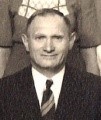 Samuel
Fox Samuel
Fox
Samuel Fox
(1903-1993). Sam went to the
RSA from Seduva in 1925 with his sister Freda. He married Dora and had 3
children, Gertie (Phillip) Lipman (moved to Israel 1977), Yudit (Jerry) Natkin
(USA) and Yetta (Paul) Nick (RSA).
Additional information Meyer Janet.
-
Shmuel Ephraim Fox (a.k.a. Sam). He arrived in South Africa with his sister
Freda, through the
beneficence of Uncle Saul Fuchs.
Family notes that the fear of
forced Army conscription motivated Sam to emigrate.
Uncle Sam had a good
physique and was light of hair and complexion, unlike his siblings.
He was fit and used to ride his bicycle to Shul in the mornings. He
laughed easily. He was close
to his sister Freda, and every morning after Shul he would ride his
bicycle to her house to have breakfast with her.
He
married Dora (Deborah) Bloch
and settled in Brakpan. Their house was at
# 92 Gardener Avenue
near to the municipal swimming pool. His shop was on Boundary Road as mentioned above. He ran
that shop until he retired. He owned beige 1948 Chevrolet Style master
in which he used to transport us to gatherings and in December to
Victoria
(Germiston Lake). This venue was nothing more than a
lake created by the mining activity in this eastern
Witwatersrand
mining city. Not very scenic, but this is where Jewish families, amongst
others from the whole of the East Rand used to congregate on Xmas Day,
Boxing Day and New Years Day in order to picnic, relax, reconnect take a
boat ride, or if you were really brave, swim in the questionable quality
water. As my father usually worked on these occasions, the
Janet Family had to rely
on either our Uncle Sam or Uncle Charlie
Itchikowitz to get us to this paradise of summer.
Their house had a Concord grape vine in the garden from which Uncle
Sam used to make Passover
vine and jam every year. It was great stuff and much appreciated except
for the one year when the fermenting process of the young wine caused
them to explode in my mom’s pantry. There also was a chicken coop in the
back garden and best of all there was a full size swing. I can recall
spending many hours on that swing and even falling off once and have the
swing hit my head, much to the consternation of my mother.
(Source Meyer Janet)
Yudit Natkin Sam's daughter's additional information:
Samuel was supposed to join Celia in
Louisville
in 1925, but the immigration laws changed and he was not allowed in the USA.
His father’s brother, Saul Fox, sent him a ticket for
South Africa.
Eta Riva, his mother, arranged for his sister Freda to accompany
him.
They
went to South Africa
via England
in a very uncomfortable journey which took 6 weeks.
He worked for a time in the Free State, but in 1929 he joined his sister,
Freda in Brakpan and opened a shop there.
Samuel was always very health conscious and did considerable body
building. I remember a
picture of him when he was 18 years old, with his arms folded and his
muscles bulging! He used to
make his muscle ripple and enjoyed the children watching him in
amazement. (Source Yudit
Natkin)
|
 Sonja
Fox Sonja
Fox
Sonja Fox Itchikowitz.
(1906-1971) She move to the RSA in 1929 and worked as a
seamstress. Married Charles Itchikowitz and had 2 children;
Shoshanna (Dave) Levy (RSA) and Louis (Bernice)
(RSA).
Additional information Meyer Janet.
-
Sheine Aide (a.k.a. Sonia)
Itchikowitz came to South Africa after her older
siblings Freda and Sam.
She was her mother Ita
Riva’s favorite as she was named after her mother. In Seduva she
helped her mother around the house after the eldest three had departed.
She also worked for the local dressmaker as a seamstress and also had
great skills as a cook. On arriving in South Africa she moved to Brakpan
to be with her family and through her mother’s connection with the Denil
family from Upina (a Lithuanian village were between 30 to 40 Jewish
families lived) Sonia was introduced and married to
Betzalel (a.k.a Charlie) Itchikowitz (more about the Itchikowitz
Family later) and after initially settling in Brakpan
moved to Somerset Road,
Geduld Extension Springs. (a mining town next to Brakpan) There they
opened a general trading store to serve the itinerant miners who were
resident in the compounds of the adjacent mines of
East Geduld, Modder East, and Hospital and New States mines.
Their shop like Sam Fox’s shop was located on a street named Boundary Road. At that time their suburb
was populated by many Jewish families.
Aunt
Sonia loved children and
used to sew clothes and make toys for the neighborhood children. I still have two teddy bears that are dressed in the
clothes that she made for them. My sister and I spent many hours playing
in their shop and in the open veld across the road from their shop. It
was through this long grass that we would see the miners coming to do
their shopping in Boundary Road.
This grass would disappear when there was a veldt fire that would leave
an acrid smell in the air. When in 1949 my parents moved into 23 Milner Avenue,
just around the corner from the
Itchikowitz family, we got to spend a lot of time in their
company. I can recall many cricket games on the back lawn and the tea
parties and evenings spent in their company. I also recall that as a
family they decided one year to drive down to Cape
Town on Holiday. A journey
of over a thousand miles. Precarious at best in their 1949 black Ford
four door custom, especially as there were no interstates and some of
the trip was through the Karoo desert. We waved them off as if they were
the “Louis and Clark” expedition out to explore the wild west of the USA.
With
the passing of the years and the closure of some of the mines, the
Itchikowitz family, like
most Jewish families relocated their businesses and dwellings to newer
up market, fashionable and viable areas of town. Therefore, in the late
1950’s (open to correction) they established Town Hall Furnishers on 2nd street across the road from
the Springs Town Hall. This specialized in 2nd
hand furniture antiques and general brick a brack as well as beads and
fabrics for the African clientele.
While we lived further apart and did not spend as much time in their
home, we would normally before or after Cheder classes, at the town’s
synagogue, visit at their shop. During the holidays we would be invited
to come and help out in the shop, especially on days that uncle
Charlie was in
Johannesburg
at auction sales. Auntie Sonia
used to feed us liberally at lunch times with cold meat sandwiches and
insisted on paying us even though we did not add much to the viability
of the enterprise. She did this out kindness as she knew that at times
our family was experiencing financial difficulties. They later expanded
and moved their store to 4TH
street
next to the Palladium Movie theatre and directly behind the major
national departmental stores of GREATERMANS and OK BAZAARS.
Uncle Charlie was a big
man with a big personality. He was opinionated and as he identified
himself as one of the “amcho”, the ordinary proletariat, he caused havoc
at local synagogue meetings by fighting against those in “die heiche
fensters” (the high windows or upper and entitled classes).. He believed
that everybody was entitled to his opinion and was an acquired taste at
committee meetings. He could always be heard davening in Shul and used
to complain if the Bal Tefillah or Chazzan was davening “like an Arab”
in his opinion. He had a good voice and sang in the synagogue choir. He
was also a gourmand who enjoyed his food and encouraged his wife to be
daring in her cooking. He was apparently younger than Sonia and on
her passing we came to realize that she was the power behind the
throne and that his bluff exterior hid the caring
person inside.
Auntie
Sonia and Uncle
Charlie were like a second set of parents to my sister Luba
and myself. (Source
Meyer Janet)
|
 Bilha
Fox Bilha
Fox
Bilha Fox Ze'elim.
(1910-1997) (Photo)
Beile Deveire (Bilha) Ze'elim emigrated from Shadeve to Palestine on June 16, 1930.
Mishmar HaEmek archives
confirm that she arrived in
Palestine
in 1930, She married
Meshullan Ze'elim and lived on Kibbutz Mishmar HaEmek.
They had 3 daughters, Michal (Jerry) Timna,
Dina (Gideon) Caspi and Osnat
(Avraham) Nitzani.
Additional
information. Yariv Timna (Israel).
Yariv is Belha's grandson, and he provided the following:
Bilha married Meshulam Zilevitz (later Ze'elim, a "better" Hebrew name),
whose family came to Palestine from Lithuania in 1912.
When Bilha came to Palestine and met Meshulam (late 1920s?) and
they became a couple. To help
Bilha's family, Meshulam married Tziporah Fox, Bilha's sister, (he had
Palestinian citizenship) so she
could get an immigration certificate for
Palestine. |
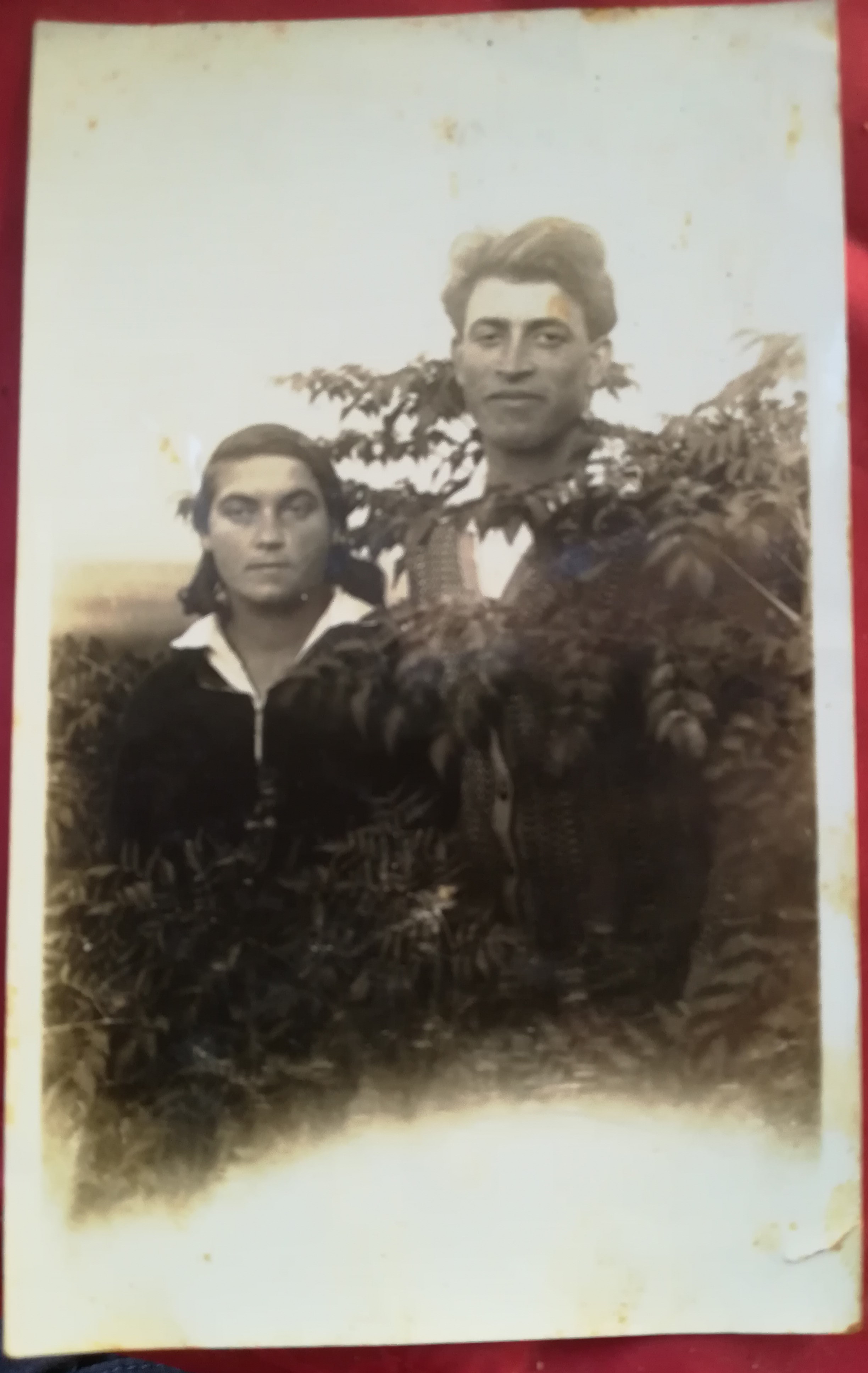 Bilha and Meshullan Ze'elim Bilha and Meshullan Ze'elim
Bilha and Meshullan officially married when my mother, Michal
(1933-2019) was born, (1933 - 2019). My mother married Avraham
Feuerstein, born 1937. Together, they had me (1961) and my brother Yossi
(1963). My parents divorced in 1964. In 1965, she married my step father
Jerry Timna. (Source Yariv Timna)
Additional information Meyer Janet:
Like her sister Tziporah, Bilha
was a member of Hashomer Ha Tsair. She
immigrated to Palestine after her father’s passing (perhaps
with a sibling). She was
also musical and creative and was more reserved than her sister
Tziporah. She married Meshulam
Tseilim. He was either born or grew up in the
village
of Afula in the Jezreel Valley.
After marriage, they moved 11 miles away to Kibbutz Mishmar Ha Emek
which had been established as a Hashomer Ha Tsair kibbutz in 1923.
During the war of independence in 1948 the Kibbutz was attacked by
Syrian troops. Meshulam was part of the kibbutz defenders who eventually repelled the
attack and helped to change the direction of the war.
In
1969 Bilha and Meshulam
visited the South African family. I remember them to be a devoted couple
who had maintained their pioneering spirit and found joy in the simple
things in life. They eschewed the material trappings of rampant
capitalism that tended not to recognize the dignity and rights of labor.
When I visited them in 1975, Meshulam had great pride in baking me one
of his signature “ugot”(cakes) in honor of my visit. In return I gave
them one of my watercolor painting to hang in their “dirah”(apartment).
(Source Meyer Janet)
|
 Tziporah
Fox Lithuania 1930 Tziporah
Fox Lithuania 1930
Tziporah Fox Rozovsky
(1911-1996) Emigrated to Palestine in 1932.
She married Boris Rozovsky, and lived on Moshav Kfar Nutter.
They had two children, Lea (Romie) Ozery, and Avraham (Ruty) Raz.
Avraham changed the family name to Raz.
I meet Tziporah and her husband in 1970 at Kfar Nutter.
I also met her son Avraham and his wife Rutie. They had a crop
spraying business. I
remember Tziporah as a cheery, friendly, farm woman.
She loved showing us her home and gardens.
Boris was a respected
agronomist in Israel.
He preformed agricultural aid services abroad for the Israeli
government. Although Boris
did not speak English, we clearly saw his sense of humor, when he
introduced us to his donkey Kasavubu, which was named for a former
president of the
Congo.
Tziporah visited the US in 1970 see her Aunt Sarah, two uncles,
sister, and other Louisville
family. There was a nice article about her visit in the Louisville newspaper. Their three children
still live on Kfar Nutter.
|
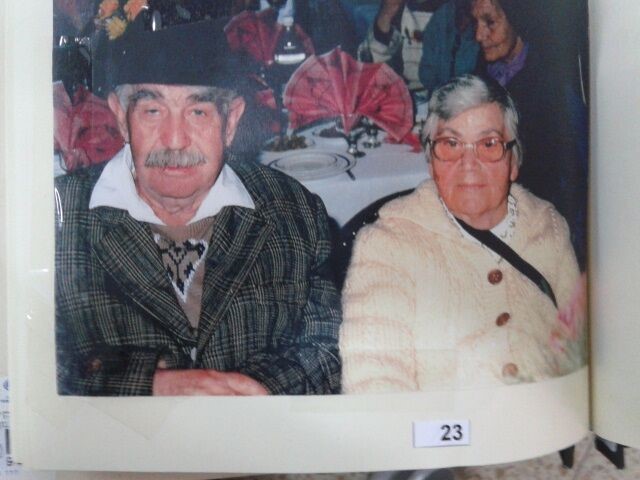 Boris
and Tziporah Rozovsky,
Israel 1990s? Boris
and Tziporah Rozovsky,
Israel 1990s?
Additional information Meyer Janet:
Feige
Rieche (Tziporah) Rozovsky.
Like her younger sisters she was a member of Jewish youth movements
back in Shadeva. She was a member of Hashomer
Ha Tsair and the Habima theatrical society. We have a picture of her
in a theater production with my father
Avrom Leib Janet. She was very pretty and had
startling blue eyes. She was quite musical and sang in choirs. After the
passing of her father she left for
Palestine
through the offices of Hashomer Ha Tsair around 1933 or 1934.
In Palestine she met and
married Boske (Boris) Rozovsky. They settled on a small holding in Kfar
Netter (Moshav) where Boris started a citrus orchard. He was a very
talented farmer and through the process of experimental grafting of
species was able to develop a new breed of Clementine which he named
“Michal”. He was duly recognized for this achievement by the Israeli
government. (Source Meyer
Janet)
Pincus
Yariv Timna states that there was
a younger brother, born after
Tziporah in the early years of the first world war.
He died as an infant from malnutrition while Label's family was
exiled in the Ukraine.
Yudit Natkin confirms this story and states the child's name was
Pincus and died at age 2.
|
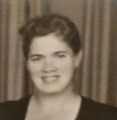 Hadassah
Fox Hadassah
Fox
Hadassah Fox Janet
(1912-2003).
Emigrated to Palestine and then to the
RSA. Married Avrum Janet and had 2 children, Meyer (now USA)
and Libbke (RSA).
Meyer Janet additional information -
-Hadassah
(Hodke) Janet (disclaimer: as this about my mother I will
do my best to be as brief and objective as with other members of the
family, but the narrative should be viewed accordingly).
My mother was born in Shadeva and was the second
youngest in the family. As a young girl she was involved in an accident
with a cart and damaged her nose. She also wore glasses all of which
translates to her looking rather studious and plain on childhood
pictures. This belies the fact that she grew up to be a stunning
brunette young lady. She grew up in a household where her older
siblings, Shule Frume, Sore Freide and Shmuel Ephraim had already left
home. After Sheine Aide left only Tziporah, Bilha and Hadassah and Pesia
were at home in Seduva. After the passing of their father all these
sisters, including my mother, left for
Palestine
as members of Hashomer Ha Tsair. My best guess is that
Hadassah and Persia
were the last to leave in about 1935.
On reaching Palestine
Hadassah blossomed. She
moved up from working as a lathe operator in an engineering works to
working at the Lieber chocolate factory to qualifying as a nurse at the
Hadassah hospital. She became so fluent in Hebrew that she was
subsequently offered a teaching post by the head of Jewish education in South Africa Rabbi Isaac Goss. She
was politically active and was a follower and acquainted with Henrietta
Szold. She was also recruited and became a member of the Haganah. She
never discussed the missions that she had been on, but did once
elaborate on the recruitment and interview process. She apparently
became proficient with a military rifle and in the assembly of Molotov
Cocktails. She had a life long aversion to right wing groups and
political leaders.
She lived in Tel Aviv and remained single although
she had a steady boyfriend by the name of Shimon, who was a Taxi driver.
Although she was a member of a socialist youth movement and her other
sisters in Palestine had become secular, she found
religion, became Shomer Shabbas, and spent her days off helping
Tziporah with her children and visiting her other sisters on
their kibbutzim.
During the Second World War her first cousin
Pini Shleime (Pinkie) Berkow,
son of Mendel Berkow was
part of General Montgomery’s 8th Army fighting General
Rommel’s Afrika Korps in North Africa.
In 1942/1943 he and his friend Charlie Blumberg got a pass to visit Palestine where
Pinkie met with Hadassah and Bilha. He brought greetings from their
mother Ita Riva, who was
living in South
Africa
with her daughter Freda.
What ever the message, it decided
Hadassah to visit with
her mother in South Africa.
Pinkie returned to Cairo and left Charlie Blumberg in charge of getting
Hadassah into Egypt
and through the Suez Canal to Durban in South Africa.
(Source Meyer Janet)
|
 Pesai
Fox Bar-on Pesai
Fox Bar-on
Pesai Bar-on
(1915-1998)
Emigrated from Shadeva to Palestine in 1935 via Keren
Kayemet to join her sister who had emigrated earlier.
She lived on Kibbutz Mabarot and married Tuvia Bar-on.
They had 3 children, Nogah (Avraham) Koren, Sarah (Shimon) Keter,
and David (Netta) Bar-on.
Meyer Janet Additional information:
Pesia (Peske) Braun.
She was the last to leave Shadeva in 1935 via the Baltic
port of Memel for
Palestine. She married a Hungarian immigrant,
Tuvia Braun and settled
on Kibbutz Ma Abarot , a Socialist kibbutz established in 1933 in the
Sharon
Valley near Petah Tikvah.
Of all the Israeli sisters she was the closest in age and relationship
with my mother. She visited
South Africa twice once in 1963 and
once in 1992. She had a beautiful smile and a peaceful nature. I stayed
with her on the Kibbutz in 1975.. She loved animals and fed all the
stray cats around her “dirah”
She
separated (or was divorced) from
Tuvia, although they both remained on the kibbutz and seemed to
have remained friends. I can recall of an evening joining him in a glass
of Spritz (wine mixed with soda). The kibbutz was like a second home as
I was made to feel so welcome by my family there. The older residents
even remembered my mother by her nickname ‘Gingie”. Later my daughter
Abigail even went to work
there in the “cheder ochel” (dining room) (Source Meyer Janet)
|

 Celia
Ginsburg 1970
Celia
Ginsburg 1970 Freda
Berman
Freda
Berman Samuel
Fox
Samuel
Fox  Sonja
Fox
Sonja
Fox Bilha
Fox
Bilha
Fox Bilha and Meshullan Ze'elim
Bilha and Meshullan Ze'elim Tziporah
Fox
Tziporah
Fox  Boris
and
Boris
and  Hadassah
Fox
Hadassah
Fox Pesai
Fox Bar-on
Pesai
Fox Bar-on